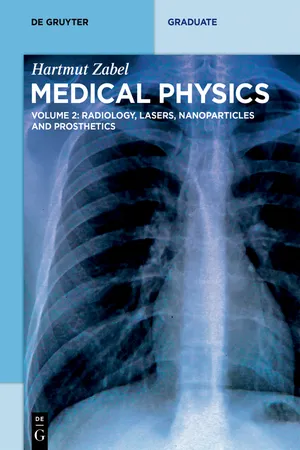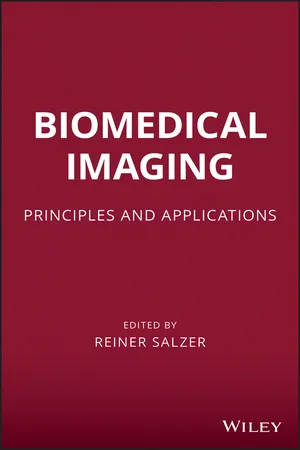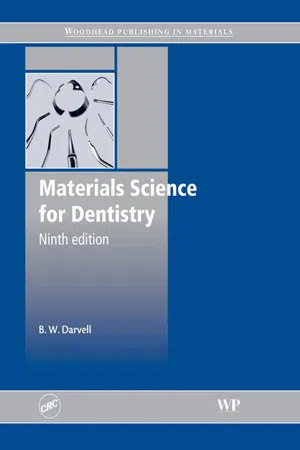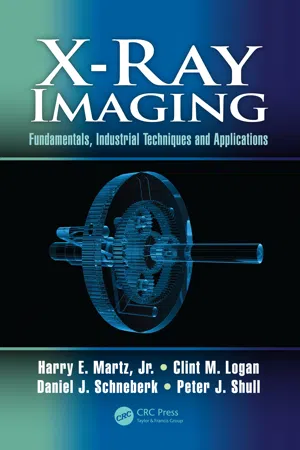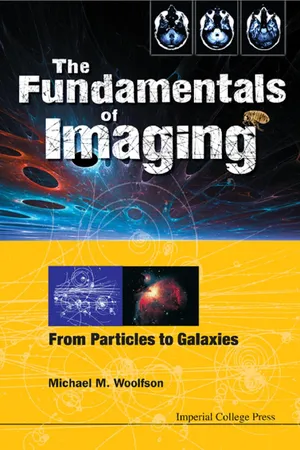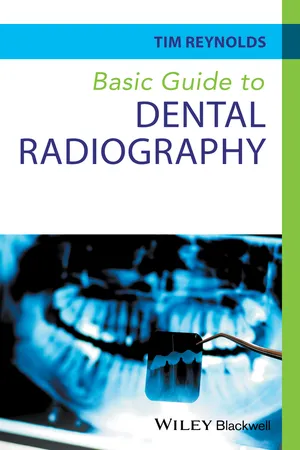Physics
X-rays
X-rays are a form of electromagnetic radiation with high energy and short wavelengths, lying between ultraviolet light and gamma rays on the electromagnetic spectrum. They are commonly used in medical imaging to visualize the internal structures of the body, as well as in industrial and scientific applications for their ability to penetrate materials.
Written by Perlego with AI-assistance
Related key terms
Related key terms
1 of 4
Related key terms
1 of 3
9 Key excerpts on "X-rays"
- eBook - ePub
Ionizing Radiation Technologies
Managing and Extracting Value from Wastes
- Shima Shayanfar, Suresh D. Pillai, Shima Shayanfar, Suresh D. Pillai(Authors)
- 2022(Publication Date)
- Wiley-Blackwell(Publisher)
3 X-ray TechnologyJeremy Brison, Rick Galloway, Christophe Malice, and Josef Mittendorfer3.1 Introduction to X-ray Technology
3.1.1 What are X-rays?
X-rays are an essential high-energy form of electromagnetic waves and therefore part of the electromagnetic spectrum like radio signals or visible light. The only difference is the shorter wavelength of X-rays. While visible red light has a wavelength of 700 nanometers, X-rays start around 10 nanometers and go down below 1 picometer. The higher the energy, the lower the wavelength. Low-energy X-rays begin with an energy of around 100 electron volts—the energy unit used in atomic physics—going up to several million electron volts (MeV) for high-energy X-rays.X-rays are a form of ionizing radiation interacting with matter they pass and transferring energy to the electrons of the atoms. Due to their energy X-rays are capable of knocking off electrons from atoms, leaving positive ions and free electrons.3.1.2 A Brief History
The discovery of X-rays is a remarkable chapter in the history of science, involving several researchers over a period of time. In experiments with gas discharge tubes, involving so called cathode rays at that time, an unassigned glow outside the tube structure was observed. The discovery of X-rays is generally attributed to Wilhelm Conrad Roentgen, who systematically studied the luminescence effect and published it in December 1895. Due to the unknown character of the new form of radiation he called it X-rays. Roentgen received a Nobel Prize in 1901, and was the first Nobel laureate in physics.3.1.3 Comparison to Other Forms of Radiation
Ionizing radiation is named for its capability of producing ions from neutral atoms. It can be grouped into two categories: radiation from natural or artificially produced isotopes and from machine sources. The first category is historically divided into three groups, two of which (alpha and beta rays) involve charged particles. Gamma rays emitted in isotope decay are electromagnetic waves and therefore uncharged. Ionizing radiation from machine sources is primarily electrons produced in accelerators. - eBook - ePub
- Hartmut Zabel(Author)
- 2017(Publication Date)
- De Gruyter(Publisher)
RadiographyPassage contains an image
1X-ray generation
1.1Introduction
In 1895 Wilhelm Conrad Röntgen discovered a new type of radiation, which he called X-rays. He was uncertain what they were, but he noticed that they were able to penetrate opaque matter. To demonstrate this he took x-ray images of his wife’s hand, the first x-ray images ever, which made him and the new method instantly famous worldwide. Since then X-rays have been known to the general public mainly for their medical use. Röntgen was the first awardee of the Physics Nobel Prize in 1901. However, medical x-ray imaging is only one of many other uses of X-rays, the others include x-ray scattering, x-ray spectroscopy, and x-ray microscopy in all fields of science and technology. X-rays from low energies to high energies are so omnipresent that a world without X-rays is hard to imagine. Without X-rays we probably would not know about the helical structure of DNA, the complex folding of proteins such as myoglobin and hemoglobin, the rich structure and functionality of ribonucleic acid (RNA), and many others.X-rays are electromagnetic (EM) waves with energies ranging from 50 eV up to several MeV, corresponding to wavelengths λ from 25nm (50 eV) down to 0.0012 nm (1 MeV). The conversion factor derived from the equation for the energy of photons E = hf = hc /λ is:λ ( nm) =1240 eVnmE ( eV)where h = 6.623 × 10−34 Js is the Planck constant, c = 299792458m/s ≈ 3 × 108 m/s−1 is the vacuum velocity of EM waves, and f is the frequency.At the lower energy end X-rays overlap with far ultraviolet radiation. At the upper energy scale they overlap with γ-radiation. It is not primarily the energy or the respective wavelength that characterizes X-rays; it is the method by which X-rays are produced. Three kinds of x-ray production can be distinguished: - eBook - ePub
Biomedical Imaging
Principles and Applications
- Reiner Salzer, Reiner Salzer(Authors)
- 2012(Publication Date)
- Wiley(Publisher)
Chapter 3 X-Ray Imaging Volker Hietschold and “Carl Gustav Carus” Department of Radiology, University Hospital, Dresden, Germany3.1 Basics
3.1.1 History
Wilhelm Conrad Röntgen was born in Lennep (nowadays a part of Remscheid/Germany) in 1845 and grew up in Apeldoorn (Holland). From 1865 to 1868 he studied mechanical engineering in Zürich, and in 1870 moved to Würzburg. After employment in Straßburg, Hohenheim, and Gießen, he was offered a professorship in Würzburg in 1888, and in 1893 he was elected as the rector of the University of Würzburg. His primary experiments were with cathode rays, which he had studied since 1894. On November 8, 1895, late in the evening, he happened to notice that a barium-platine-cyanuere coated screen fluoresced each time he switched on the cathode ray tube (a Hittorf-Crooke tube). This fortunate observation allowed him to reach the conclusion that the radiation responsible for the fluorescence must be able to penetrate opaque materials. About six weeks later, on December 22, he took the famous X-ray of his wife Bertha's hand (Leicht, 1994; Schedel, 1995). Röntgen termed this “unknown radiation” he had discovered “X-Strahlen” (X-rays). Although this terminology was kept unchanged by the English-speaking world, the radiation is called in German and (rentgenovskoe izluenie) in Russian, to honor its discoverer.3.1.2 Basic Physics
X-rays are part of the electromagnetic spectrum. By definition, X-rays are photon radiation generated either by the rapid acceleration (or deceleration) of charged particles (“Bremsstrahlung,” from the German bremsen = to brake and Strahlung = radiation) or as a result of high energy transitions between the electron shells of atoms or molecules.For diagnostic applications, X-rays usually are produced in X-ray tubes, in which electrons, accelerated to a certain kinetic energy using a high voltage, are shot onto a metallic target. They are decelerated mainly by the Coulomb interaction with the electron shell of the target material, and the difference in kinetic energy is emitted as electromagnetic radiation (bremsstrahlung). The intensity of bremsstrahlung is continuously distributed with a linear decrease down to the initial kinetic energy of the electrons. If the kinetic energy is sufficient to strip an electron from the inner shell of the target, an electron from the target's outer energy level may transition to this unoccupied energy level. The energy difference between the initial and final energy levels of the transitioning electron is emitted from the target's electron shell in the form of a photon. This emitted photon will have an energy characteristic of the electron shell of the target material. The contribution of this process to the energy distribution obtained from an X-ray tube (Fig. 3.1 - eBook - ePub
- B W Darvell(Author)
- 2009(Publication Date)
- Woodhead Publishing(Publisher)
The utility and limitations of intensifying screens are outlined. However, alternative techniques are displacing film in favour of digitial images. In terms of handling, image interpretation and radiological protection it is clearly important to understand the nature of X-radiation and its interaction with matter. It is this interaction that ties the subject to dental and biomedical materials. No distinction can be drawn in this sense between biological tissues and the foreign materials that may be present, but the discrimination of the two may be critical. Radiography is a procedure used both clinically and industrially to obtain information non-destructively about the internal structure of objects. While the anatomical interpretation of clinical radiographs is of no concern here, that interpretation depends ultimately on the interaction of radiation with matter, both in the object being investigated and in the recording medium. That brings radiography firmly within the ambit of materials science. It is therefore considered important that these interactions be considered as an adjunct to understanding the interpretation process, especially since non-biological materials will frequently be present in the field, e.g. if any prior restorative treatment has been done. §1 Atomic Structure As was noted in 24§6, electromagnetic radiation may interact with matter in a variety of ways, depending on the wavelength of that radiation. So-called X-rays 1 are associated with changes in the energy of inner electrons. The electron configuration of an atom, that is, the distribution of the electrons among the various available orbitals 1 s, 2 s, 2 p and so on, is governed by the Aufbau Principle. This effectively says that in filling the available set of atomic orbitals the electrons are placed in order of decreasing stability, with the added proviso of the Pauli Exclusion Principle. This states that no two electrons in one atom may have identical sets of quantum numbers - eBook - ePub
X-Ray Imaging
Fundamentals, Industrial Techniques and Applications
- Harry E. Martz, Clint M. Logan, Daniel J. Schneberk, Peter J. Shull(Authors)
- 2016(Publication Date)
- CRC Press(Publisher)
4 Physics of X-Ray and γ-Ray Sources4.1INTRODUCTION
In this chapter, you will be introduced to the physics of high-energy photon sources. In this text, high-energy photons mean electromagnetic radiation that is higher in energy than other more common electromagnetic radiation such as visible and ultraviolet photons (see Figure 4.1 ). Depending on their origin, these photons may be X-rays, gamma-rays (often denoted by the Greek letter gamma, γ), or annihilation radiation.Upon completion of this chapter, you will be able to understand the following:- Types and sources of high-energy photons
- Generation of X-rays by electrons
–Bremsstrahlung (braking or decelerating electrons) –Characteristic X-rays –Accelerating charge
- Where γ-rays come from
- Source of annihilation radiation
- Units used to characterize and describe high-energy photons
- Generation of X-rays by electrons
4.2TYPES OF HIGH-ENERGY PHOTONS: X, γ, AND ANNIHILATION RADIATION
Radiation of an unknown type and origin was discovered in the year 1895 by Wilhelm Röntgen. They were dubbed X-rays by their discoverer, while in his honor, some referred to them as Röntgen rays. They were soon found to be a form of electromagnetic radiation with extremely short wavelengths (very high energy). X, γ, and annihilation radiation are called ionizing because their interactions with matter can eject electrons* from an atom,† creating a positively charged ion. Here we provide the physics of how X-rays, γ-rays, and annihilation radiation are produced and how they differ in definition only. X-rays are a highly energetic form of electromagnetic radiation generated by accelerated or decelerated electrons or atomic energy (i.e., electronic) transitions. They have extremely short wavelengths (6.0 × 10−12 m to 1.5 × 10−8 m); most are smaller than the size of an atom (~10−10 m). γ-rays are an energetic form of electromagnetic radiation produced by nuclear energy (neutron or proton) transitions, typically by radioactive decay. Annihilation radiation is electromagnetic radiation produced when a positron* (β+ ) and electron (β− - eBook - ePub
The Fundamentals of Imaging
From Particles to Galaxies
- Michael Mark Woolfson(Author)
- 2011(Publication Date)
- ICP(Publisher)
Fig. 14.3 . Medical radiography quickly became, and still is, an essential diagnostic technique. For the important discovery of X-rays Röntgen was awarded the first Nobel Prize for Physics in 1901.It took some time for the danger of overexposure to x-radiation to be discovered and x-ray generators were sold freely as a means of home entertainment to look at bones within the body; there must have been many premature deaths due to this cause.14.2. X-ray Generators
X-rays are a form of electromagnetic energy of extremely short wavelength, typically 0.1 nm.1 In many applications of X-rays it hasFigure 14.3 A radiograph taken by Röntgen of the hand of Albert von Kolliker.been found convenient to express wavelengths in terms of another unit, the Ångstrom unit (Å) that is 0.1nm = 10−10 m. The simplest way to produce X-rays is to fire a beam of very high-energy electrons at a metal target, one preferably made of a heavy metal. The electrons, colliding with the metal atoms, lose energy in one or more interactions and each energy loss is converted into a photon, a packet of electromagnetic energy. The energy of a photon of wavelength λ is given bywhere h is Planck’s constant, 6.626 × 10−34 Js, ν is the frequency and c is the speed of light, 2.998 × 108 ms−1 . From this equation the energy of an x-ray photon of wavelength 1 Å is found to be 1.99 × 10−15 J. It is customary in many scientific contexts to express atomic-scale energies in units of electron volts (eV), the energy of an electron that had been accelerated by a potential difference of 1 volt. This unit is equivalent to 1.602 × 10−19 J, giving the energy of a 1 Å photon as 12.42 keV.2 - eBook - ePub
Methods and Applications of Statistics in Clinical Trials, Volume 2
Planning, Analysis, and Inferential Methods
- Narayanaswamy Balakrishnan, N. Balakrishnan(Authors)
- 2014(Publication Date)
- Wiley(Publisher)
Figure 9b . Only a few photons are emitted with the full 100 keV of energy of the incident electrons, and the vast majority are radiated away with far less.The measured spectrum for a real X-ray tube differs from this straight-line, curve B, For reasons soon to be discussed, the rate of X-ray absorption by materials in creases rapidly the lower their energy. This means that as newly minted X rays emerge from (sometimes deep) within the target itself, pass through the glass window of the X-ray tube, and even through intentionally placed filters (usually aluminum), C, the lower-energy ones are preferentially removed. This is good, because these low- energy X rays do not penetrate far through tissues, and therefore cannot contribute to image formation, but they will deposit dose, and there is a very slight chance that this will lead to adverse health effects. The most energetic characteristic X rays photons for tungsten, incidentally, lie in the range from 58 to 69 keV.The X rays emerging from a tube pass through an adjustable beam collimator (Figure 7 ), again. The result of all this is that a nearly uniform, rectangular beam of X rays of appropriate dimensions exits the tube via its window and heads off toward, say, a patient’s hand.14.2.3 Exponential Attenuation of a Narrow Monochromatic Beam by a Homogeneous Medium
Electromagnetic radiation can interact with matter by various mechanisms. The relative probability that a photon will collide with an atomic electron depends on the energy of the photons and on the nature of the material; physicists have expended much of their efforts over the past century in learning about those processes.The attenuation of a narrow X-ray beam in passing through soft tissues, bone, or IR materials, in particular, is easily studied by experiment (Figure 10a ). The intensity of the beam, I(x) (the amount of X-ray energy passing through a unit area per second), is monitored as different thicknesses, x, of the attenuating material are inserted into the beam path. I(0) is the intensity when there is no attenuating material in its path, x - eBook - ePub
- Jeff C. Bryan(Author)
- 2018(Publication Date)
- CRC Press(Publisher)
13 X-ray ProductionX-rays are used extensively in diagnostic and therapeutic medical applications. This chapter starts by looking at how X-rays are generated for diagnostic applications, such as those performed in hospitals and dentist offices, and then moves into how high-energy X-ray beams are produced for radiation therapy. Interestingly enough, knowledge of how electrons interact with matter (Section 6.2 ) is key to understanding how X-rays come about.13.1Conventional X-ray BeamsFor diagnostic medical applications, such as an X-ray of your foot to see if any bones are broken, we’d like to consistently produce high-energy photons on demand—a flip of the switch to provide the same energy and intensity every time would be great. It is also desirable for our photon generator to be safe and affordable. The only source that satisfies all these requirements is a particle accelerator. A conventional X-ray tube is a small particle accelerator (Section 9.4 ). Let’s see how it works.A schematic of a typical conventional X-ray tube is shown in Figure 13.1 . The filament is a tungsten wire, much like those used in (old-school) incandescent light bulbs. If we run a little electric current through the filament at a high enough voltage, we can get electrons to boil off the wire. The filament is, therefore, a cathode.Figure 13.1 Schematic of a conventional X-ray tube.After they jump off the cathode, the electrons are accelerated toward the positively charged anode (target). The maximum energy they attain will be equal to the potential difference (tube voltage) between the two electrodes. For all this to happen, both electrodes need to be under vacuum, so the whole X-ray tube is enclosed and pumped out. This is important because the electrodes would rapidly corrode if exposed to oxygen and because the electrons could interact with any matter (gases) on their way from the filament to the target.Electrons won’t boil off the cathode unless the filament is pretty hot. The current of electrons flowing through the wire (filament current ) does this—just like a toaster! Since it will get hot, it’s important to make the filament out of a metal with a high melting point. Tungsten melts higher than any other metal (3370°C), so it works quite well. The filament current is usually set at a few amps. The other current flowing in the tube is made up of the (relatively few) electrons moving from the cathode (filament) to the anode (target). This is called the tube current - eBook - ePub
- Tim Reynolds(Author)
- 2016(Publication Date)
- Wiley-Blackwell(Publisher)
X‐rays are part of the electromagnetic spectrum; this range of radiations includes radio waves, microwaves, visible light, X‐rays, gamma rays and cosmic rays. Radio waves are low‐energy radiation, light somewhere in the middle and X‐rays towards the top of the total range of energies.They all share the same general physical properties: they are electromagnetic radiations, and they all therefore have both an electric element and a magnetic element. The two elements (electric and magnetic) have a wave nature similar to the one we used to show alternating voltage and current, that is, a sinusoidal waveform. The electric and magnetic waves lie and move at right angles to each other (Figure 2.14 ).Electromagnetic radiations (configuration of electric and magnetic waves)Figure 2.14A feature of electricity that we did not discuss previously is that if you have an electric current flowing in a conductor, there will also be a magnetic field. Similarly if you move a magnet close to or within an electrical conductor, you will get an induced voltage, and if there is a complete circuit, a current will flow.This is called electromagnetic induction.If you studied combined sciences or physics at some point in the past, you may have conducted a simple experiment to show this phenomenon (Figure 2.15 ).Electromagnetic inductionFigure 2.15Pushing the magnet into the coil of wire will cause the meter needle to flick in one direction; pulling the magnet out will cause the meter needle to flick in the other direction. By constantly pushing it in and out, you could set up your own alternating voltage and current.If you put the magnet into the coil and leave it there, nothing happens as it is the movement that produces the voltage. If you place a piece of steel into the coil and pass a current through the coil, the steel will become magnetic. In fact even without the steel in place, there would be a magnetic force; the steel just intensifies it.So moving magnets will induce voltage and current and moving current will induce magnetism. This is exactly the situation we have in a quantum of X‐radiation. There is a moving electric and moving magnetic element making up the whole thing. These two elements are able (effectively) to create each other and they are therefore mutually supportive (each one props up the other). This means that unlike most waves they do not simply die out; they will go on forever unless they are acted on by another force that uses up their energy.
Index pages curate the most relevant extracts from our library of academic textbooks. They’ve been created using an in-house natural language model (NLM), each adding context and meaning to key research topics.
Explore more topic indexes
Explore more topic indexes
1 of 6
Explore more topic indexes
1 of 4

